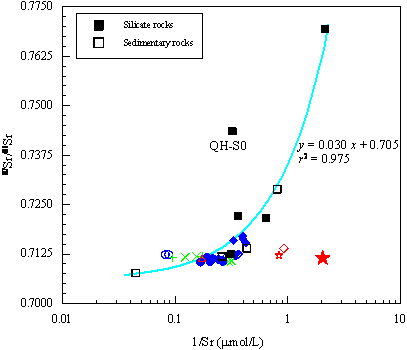Assessing modern earth surface processes is of first-order basis for better interpreting proxies of sediments; the latter is one of the primary goals of paleoclimatic research. BecauseSr isotopes do not fractionateduring mineral precipitation, Sr isotopic compositions of authigenic/biogenic mineralsrecord those of the water in the past, allowing us to evaluate the balance of Sr inputs from various sources and theirrelative contributions under various conditions. For a hydrologically closed basin such as Lake Qinghai with high-resolution paleoclimate records available from sediments, the geochemical behaviour of Sr is important in determining the effects of authigenic/biogenic mineralformation on the dissolved elements of the water and/or the sediment.
Prof. Jin Zhangdong of Institute of Earth Environment, CAS and his group initiateda comprehensive chemical and isotope study of waters of Lake Qinghai since 2006 to understand how catchment weatheringconstrains river water chemistry and how the lake develops its current characteristic chemical compositions. Importantly, such detailed study allows 87Sr/86Sr application of authigenic/biogenic carbonates to inferring variability in water sources to the lake using paleo-records. The main conclusions include:
(1)The chemical components and 87Sr/86Sr ratios of the alkaline waters are derived from mixing of carbonate and silicate sources,with the former contributing 72±18% dissolved Sr to rivers;
(2) A steady-state calculation gives an estimate for the groundwater flux, accounting for about 8% of contemporary lake Sr budget;
(3)The water sources within the catchment have distinct chemical and Sr isotopic compositions, and the difference among them reflects the control of age and type of rocks on the water chemistry within the catchment;
(4) The water chemistry of the Buha Riverdominates Sr isotopic composition of the lake water, being buffered by the waters from the other rivers and probably by groundwater. However, precipitation of authigenic and/or biogenic carbonates makes the chemistry of the lake itself differing remarkably from the rivers, with a very low Ca and Sr, but very high Na, K, and Mg relative to the rivers.

Fig.1 Mixing plot of reciprocal Sr and 87Sr/86Sr of rocks, river and lake waters within the Lake Qinghai catchment. (Credit to Jin et al.,)

Fig.2 Mixing plots of 87Sr/86Sr versus molarCa/Na, showing that Sr in the Lake Qinghai waters is mainly derived from four principal reservoirs.Radiogenic Sr to the system is mainly derived from thecarbonates and the sandstoneswhereas others are “diluting” their radiogenic signatures.(Credit to Jin et al.,)
Related paper entitled “Weathering, Sr fluxes, and controls on water chemistry in the Lake Qinghai catchment, NE Tibetan Plateau” by Jin Z D, Wang S M, Zhang F, et al. is published in Earth Surface Processes and Landforms (2010, 35(9): 1057-1070).
 © 2015 Institute of Earth Environment,CAS
© 2015 Institute of Earth Environment,CAS Address:No. 97 Yanxiang Road, Xi'an 710061, Shaanxi, China

 Location :
Location :